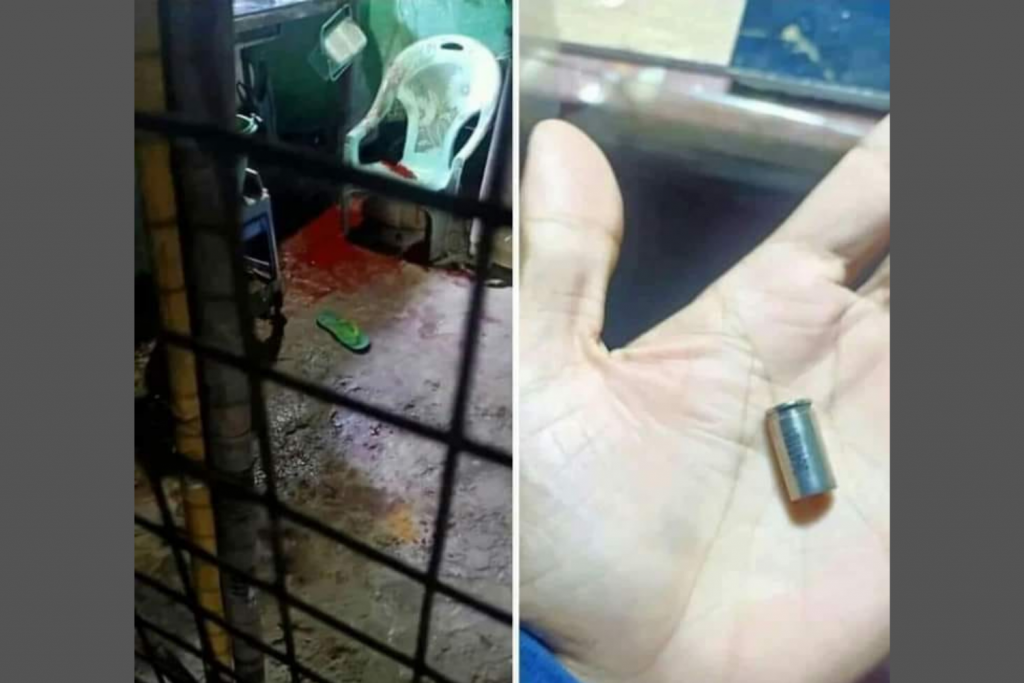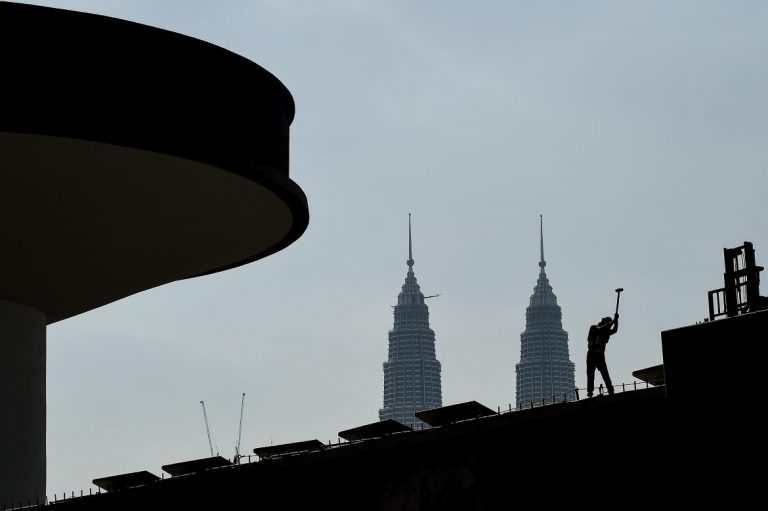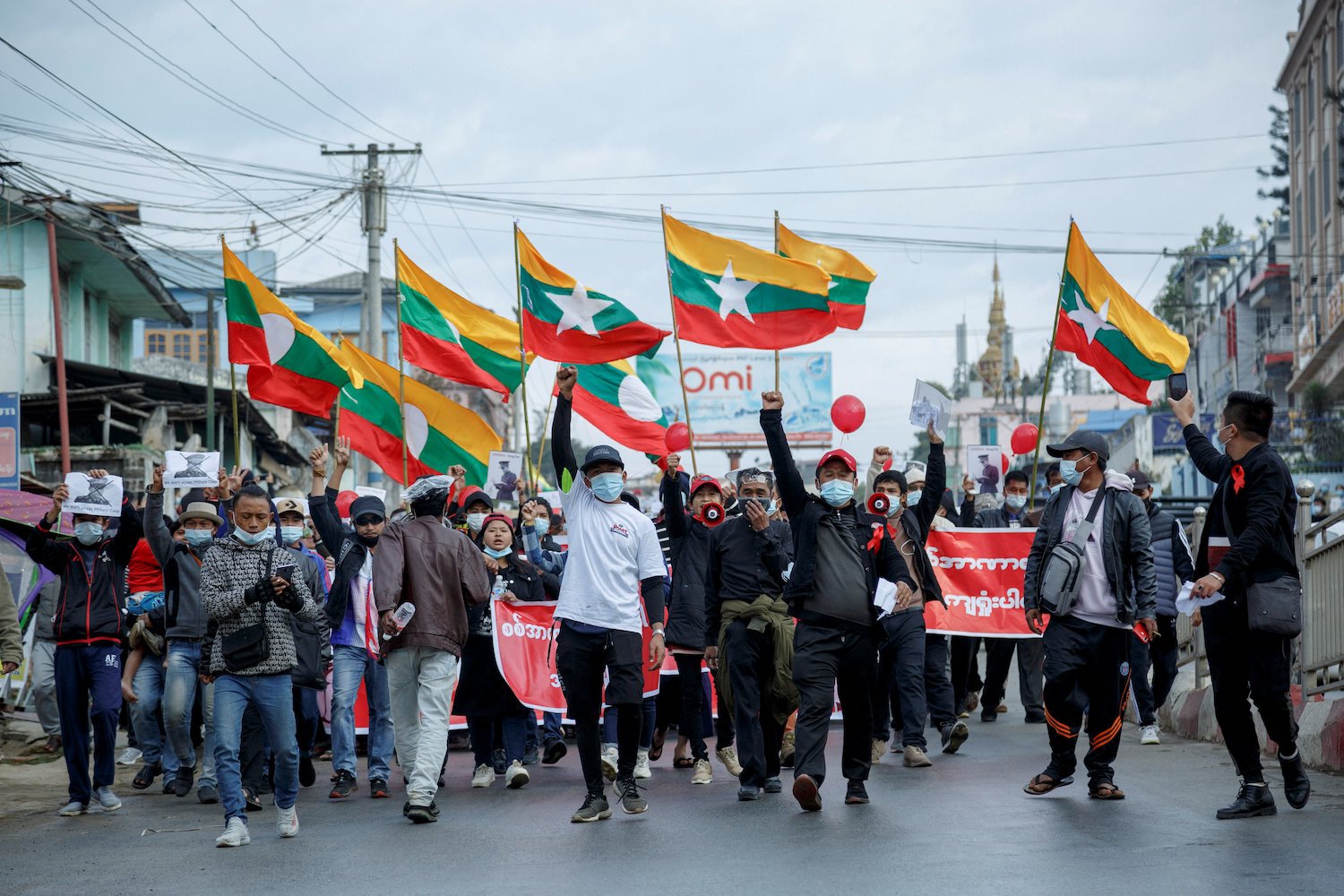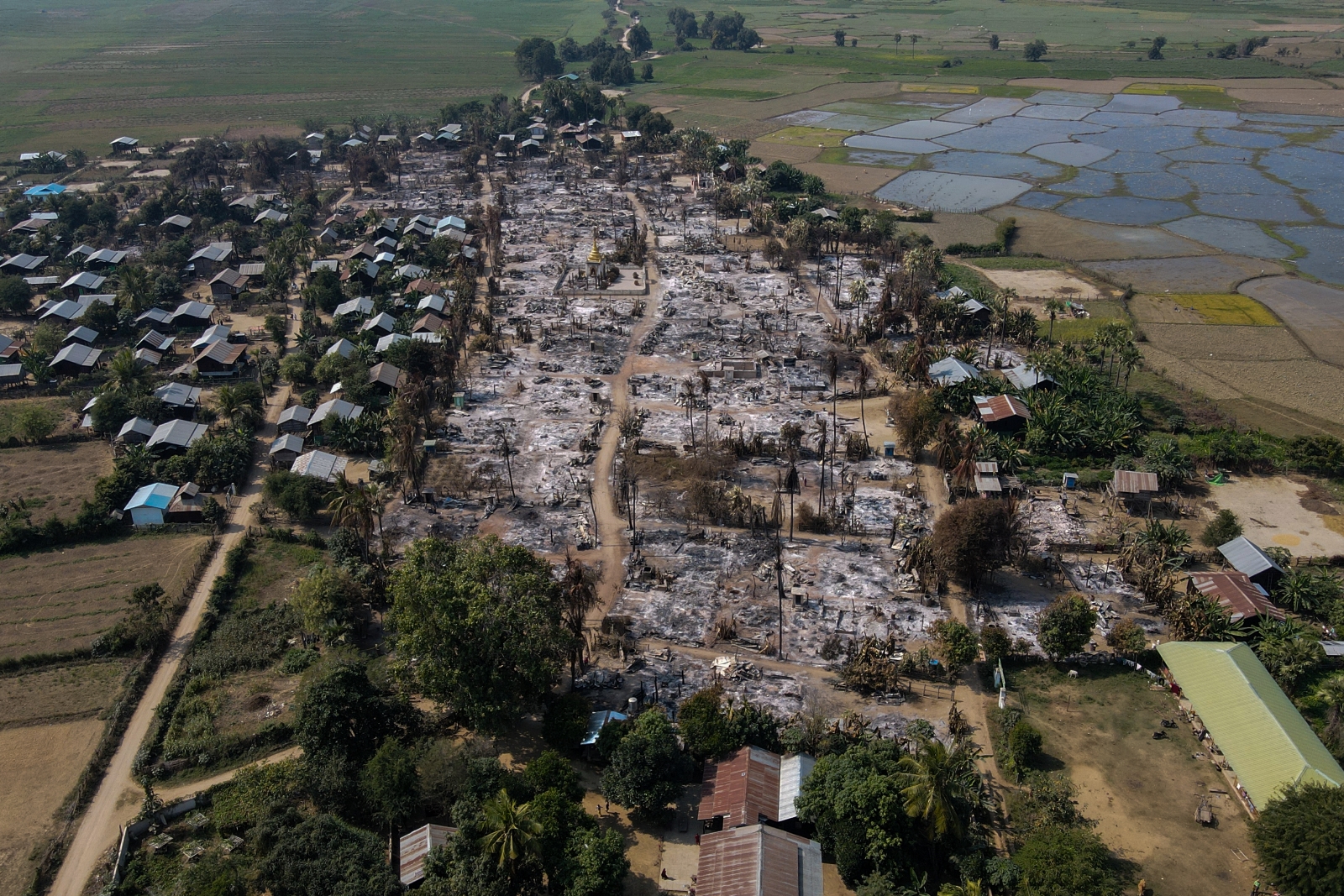A network of hardline, pro-military groups known as Pyusawhti is doing its best to spread terror among the population as it fights a dirty war against the democratic forces resisting the coup.
By FRONTIER
At about 10:30pm on June 6, two men on a motorbike entered Tha Pyay Thar Road in Yangon’s Mayangone Township and threw what witnesses said were Molotov cocktails at a primary school before disappearing into the night.
The arson attack occurred after the junta-imposed curfew took effect at 10pm and, curiously, electricity along the road had just been cut.
Nearby residents raised the alarm when the school caught fire and many rushed to help.
“As soon as I heard people shouting that the school was on fire, I ran out of the house and joined the other people trying to put it out,” said Ko Htike Thu, 20, who asked that his real name not be used.
After the fire was extinguished, ward administrators and Tatmadaw soldiers arrived to inspect the crime scene, but the arsonists were never caught.
“People on our street believe that the fire was the work of Pyusawhti,” said Htike Thu, referring to a recently formed pro-military network. “No one can go outside during curfew. Only Pyusawhti can ignore the curfew because it is partners of the military,” he added.
The network, named after a famous semi-mythical Bamar warrior prince from the second century CE, is alleged to be working with the junta to launch attacks aimed at spreading terror and tarnishing the reputation of the People’s Defence Forces and other resistance groups.
Pro-military civilians
Pyusawhti also shares its name with a town and village defence scheme established by U Nu’s civilian government in 1956 to assist the Tatmadaw in counter-insurgency activities. Some Pyusawhti groups quickly fell under the control of influential politicians and were known as a “party army”, writes John Buchanan in Militias in Myanmar, published by the Asia Foundation in 2016.
It is unclear when the latest incarnation of Pyusawhti was formed, or by whom, but the purpose seems clear: to work with security forces against those opposed to the military.
The groups have increasingly been in the news since mid-May, when they became more active in response to a wave of attacks targeting junta-appointed ward and village tract administrators and their offices.
On May 14, a letter from Pyusawhti leaders calling on the group’s members to infiltrate anti-junta organisations and inform on their members to the military circulated on social media. The letter also called on Pyusawhti members to help undermine support networks for the Civil Disobedience Movement.
Around the same time, social media pages and groups using the name Pyusawhti became more noticeable, and many of them published threats against members of the National League for Democracy and those helping to fund the CDM.
On July 2, a couple were gunned down at their home in Mandalay Region’s Myingyan town in killings blamed on Pyusawhti. Both NLD members, the husband and wife were killed six days after a local Pyusawhti group had included them on a list of 38 NLD members in Myingyan it said would be targeted in retaliation for any attacks on personnel or institutions linked to the State Administration Council.
On July 5, an NLD ward official from Yangon’s South Dagon Township, U Khin Kyaw, was shot and killed in his home, reportedly by Pyusawhti members. His wife was injured in the attack.
These attacks have left some NLD supporters shaken. Mayangone resident Ko Yan Aung (not his real name), 28, said he feared for the safety of his mother, who is an NLD ward official. “A lot of people know she is an active NLD member in our area, so I’m worried that Pyusawhti might target her.”
“Pyusawhti is very dangerous,” said Ko Moe Thway, chair of pro-democracy youth group, Generation Wave. “Military leaders have created an armed group to oppress the people and activists. It can hurt a lot of civilians.”
Moe Thway believes that most Pyusawhti members are also supporters of an extreme Buddhist nationalist group, the Association for the Protection of Race and Religion. Better known by its Burmese acronym as Ma Ba Tha, the group was ordered to disband in 2017 by the supreme organisation representing the monkhood in Myanmar, the State Sangha Maha Nayaka Committee. Ma Ba Tha has been repeatedly accused of inciting anti-Muslim violence in Myanmar.
Moe Thway said all of Pyusawhti’s pages and accounts on social media stress the importance of amyo (race), batha (religion), sasana (the Buddha’s teachings), and of the military. Similar language has been commonly espoused by members of Ma Ba Tha.
There is often an overlap in Myanmar between religious nationalism and support for the military, which styles itself as the protector of both the nation and of Buddhism.
“These [Pyusawhti] groups are the supporters of the Tatmadaw,” Moe Thway said. “They changed the group’s names to suit the situation.”
‘Find the PDF members’
Unlike its 1950s namesake, the Pyusawhti network operates from the shadows, which makes it difficult to contact Pyusawhti leaders for comment.
When Frontier called the contact number on the Facebook page of a Yangon-based group, a person who declined to identify himself answered and said that not all groups using the Pyusawhti name are genuine. “A lot of Pyusawhti groups have been formed and there is confusion. Some fake Pyusawhti groups have been formed by the red side,” he said, referring to the NLD.
Asked about allegations that Pyusawhti had bombed or set fire to schools, he implied that the attacks were being carried out by those who oppose the coup. “People know who carried out that violence. They already know who the terrorists are. In time, people will know who is responsible for this violence,” he said.
He declined to say if his group was collaborating with the military.
On June 14, Frontier Myanmar was among some independent media organisations that were sent a conversation purportedly recorded with the leader of the Bago Pyusawhti by an undercover reporter pretending to be a potential recruit.
In the audio file, the Bago Pyusawhti leader calls on group members to find out who in their communities is working with the National Unity Government or has been trained by an ethnic armed organisation.
“You need to live secretly in your ward so people won’t know you are a member of Pyusawhti, and find out who are the PDF members and who has come back from [military training] at ethnic armed group areas,” he said, in comments that are in line with the May 14 letter circulated on social media. “If we inform on them, the military will take the next step.”
Both the Yangon and Bago Pyusawhti officials said the groups were formed by people who “want stability”. The almost identical language used by both men suggested they may have been instructed on how to respond to the question.
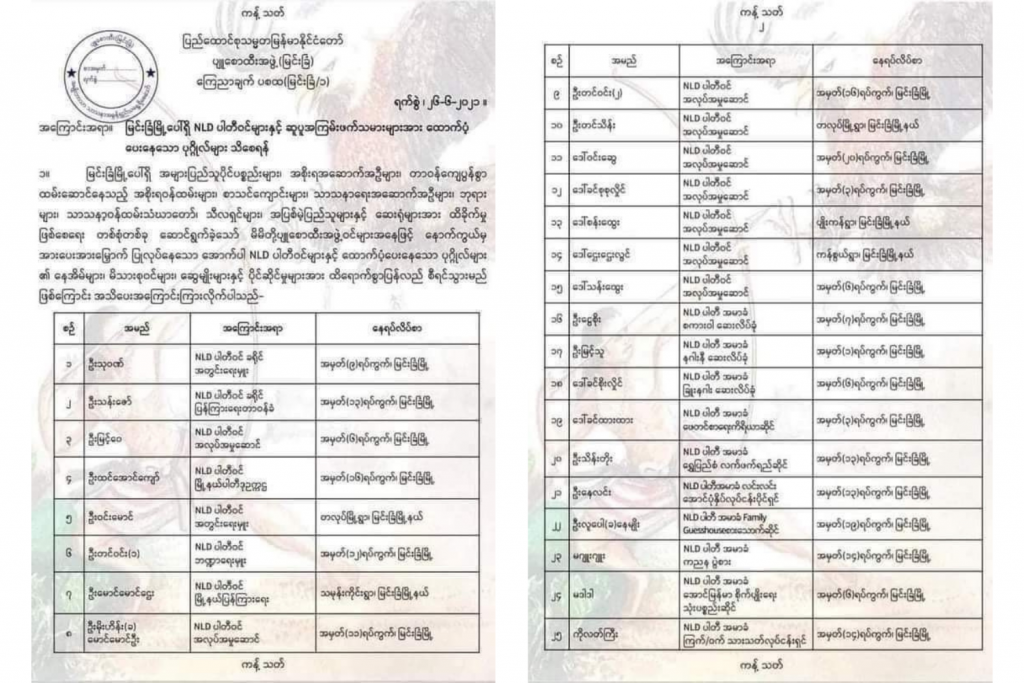
‘Kill the dalan’
But opponents of the military are fighting back against this new perceived threat.
Thunderstorms Without Borders, an underground guerrilla group in Sagaing Region that is not affiliated with the NUG, told Frontier that as of July 6 it had killed eight people suspected of being close to Pyusawhti.
Thunderstorms Without Borders says they investigate suspected Pyusawhti members based on information they receive from residents. “If a lot of people are hurt or arrested because of a suspected Pyusawhti, we kill the dalan,” said Ko Ayee Aka, 37, the guerrilla group’s leader, using the Burmese word for “informer”.
Thunderstorms Without Borders said on its social media page that it killed three Pyusawhti members in Mingin Township on June 3 and someone who was financially supporting the group on June 6.
Ayee Aka said his group interviews witnesses and gathers solid evidence before assassinating Pyusawhti members.
He estimated that there are at least 50 members of Pyusawhti in Sagaing Region. Frontier is unable to independently verify if those killed were affiliated with Pyusawhti or how many members are operating in the region.
Ko Myo Aung, a member of the Mingin PDF, told Frontier that Pyusawhti is especially active in the township because it is a stronghold of the military-aligned Union Solidarity and Development Party. “The USDP is strong here, so Pyusawhti is more active in our township,” he said, adding that most of the group’s members are middle-aged and include a large number of Tatmadaw veterans.
In 2015, the USDP won the Pyithu Hluttaw seat of Mingin and Mingin-2 in the state hluttaw, but in November’s election the NLD won all seats in the township.
Myo Aung said Pyusawhti groups were being directly supported by the junta’s Ministry of Information and the USDP. Frontier is not able to independently verify those claims.
When Frontier asked USDP spokesperson U Nanda Hla Myint if any party members belonged to Pyusawhti, he said he could not answer because he was travelling and has declined subsequent calls.
Discrediting the revolution
Democracy activists believe that the junta is using Pyusawhti groups to provoke civil unrest in a bid to retrospectively justify the coup. “If there is more violence between Pyusawhti and other civilians, it is profitable for the military regime,” said Moe Thway. “If violence occurs, they can say the coup was necessary.”
Ko Lin Maung, 38, an activist and former political prisoner who asked that his real name not be used, believes that the midnight bombing and burning of schools may be the work of Pyusawhti groups aimed at discrediting PDFs and guerrilla groups.
Lin Maung and Moe Thway are concerned that Pyusawhti’s activities will escalate to attacks in public places, such as markets, schools, religious buildings and hospitals, with the objective of damaging the image of anti-coup forces.
“The military council has set up Pyusawhti to distort the revolution; if they attack under the guise of PDFs, it could hurt the revolutionary forces,” said Lin Maung, adding that the military has created similar groups during uprisings or protests in the past against military dictatorship.
There have been more than 300 bombings throughout the country since the coup, Radio Free Asia has reported. Many remain unattributed, although urban guerrilla groups have claimed responsibility for some bombings and assassinations in public spaces. But Lin Maung said that when it came to the PDFs and “Gen Z revolutionary forces”, ordinary people had “nothing to worry about”. “They are fighting for democracy and human rights,” he said. “Pyusawhti, on the other hand, is for the coup junta.”
He believes that because the PDFs are required to adhere to a code of conduct that they could not be responsible for attacks on targets such as schools. “What can we do if Pyusawhti members blame the NUG?” he said angrily.
Ayee Aka said Pyusawhti members are doing more than informing. “They are being trained by the military council; some Pyusawhti members have grenades and M-16s,” he said.
The nighttime bombings of NLD offices in Mandalay on June 13 and Yangon on June 16, and the bombing on June 14 of the Mandalay home of detained regional chief minister U Zaw Myint Maung, a vice chair of the NLD, have all been attributed to Pyusawhti.
“No revolutionary group would attack NLD offices; only Pyusawhti and the military would attack them,” said Ko Kyaw Kyaw Oo, a member of a Yangon-based urban guerrilla group who asked that his real name not be used. Frontier was unable to independently verify who was responsible for the bombings.
PDF and guerilla groups have say that if Pyusawhti becomes stronger they will respond by targeting more of its members with bombings and assassinations.
Stoking sectarian tension
On June 10, a fire broke out at an Islamic school in Yangon Region’s Dala Township, on the southern side of the Yangon River across from the downtown area. There were rumours that Pyusawhti was responsible for the fire, although initial media reports blamed an electrical fault.
Nationalist accounts on Facebook then began claiming that the fire was caused by explosives hidden on the campus. The accusation that Muslims are hiding weapons has often been used in the past by nationalists and the military to foment communal violence.
Resident Ko Min Oo, 26, said the fire and subsequent rumours had created concern in the community that Pyusawhti was seeking to create sectarian strife. “People are very scared; we have increased security at mosques,” he added.
Meanwhile in Sagaing Region, Mingin PDF says three Pyusawhti members donned military uniforms to join a raid by soldiers on the homes of NLD supporters in the Taung Twin area of the township on June 12. Mingin PDF also says that about 50 Pyusawhti members in civilian clothes fought beside the military in a battle against the PDF on the border of Mingin and Kani townships on June 15.
“The Pyusawhti involved in the attack were locals from Mingin. The city is not very big, so we know who is who,” said a Mingin PDF member who requested anonymity. Frontier was unable to independently verify his comments.
Pyusawhti members are also believed to have helped the security forces break up protests in Mandalay city. “Armed people wearing civilian clothes arrested protesters in Mandalay in May and there were rumours they were Pyusawhti,” said Kyaw Kyaw Oo, the guerilla group leader from Yangon.
Frontier cannot independently verify who arrested the protesters.
Ayee Aka is concerned that Pyusawhti groups could create a false impression of fighting with and among civilian groups, and the military will use this “chaos” to justify the coup. “The revolution could end because of Pyusawhti,” he said.
Min Oo, meanwhile, appealed to all armed groups – the Tatmadaw, Pyusawhti, PDFs and guerrilla groups – to refrain from attacking schools, markets, hospitals or religious buildings.
“I do not want them to attack anywhere,” he said. “But if they attack, there’s nothing we can do about it.”


